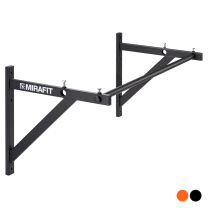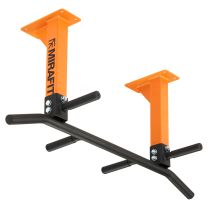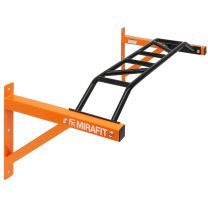Pull up bars are one of the best pieces of equipment for developing stronger biceps, because you have your whole bodyweight on your arms.
Pull up bars are compact and can be placed either on a wall, ceiling or as part of a rack. They don’t take up too much space and they’re great for training regularly. Do some before work, after work or every time you pass the bar.
Use them to develop your back and core. And if you’re finding pull ups too hard or too easy, there are lots of ways you can supplement your training to get you where you want to be.
Pull Up Bars
Pull Up Bars

WHAT IS A PULL UP BAR?
A pull up bar is made up of a bar to grip hold of and two brackets which can be mounted on a suitable wall or ceiling. Pull up bars are used to train the back, biceps and shoulders but can be used for a range of core exercises too.
They’re ideal for anyone looking to train using their own bodyweight. And perfect if you want to practise and train regularly at home.
A straight pull up bar allows you to easily vary your workout between wide and narrow grip positions. You can also get multi grip pull up bars which are great for helping to vary your workouts further and keep a more neutral grip – which can help if you have any issues with your joints.
Power racks usually also come with a pull up bar built in. So, if you’re thinking of setting up a home or garage gym, this is great way of including a pull up bar in your set up without the need to drill into walls or ceilings.
WHY TRAIN WITH A PULL UP BAR?
Pull ups are one of the best ways to train your back muscles and build a v shape. And bodyweight exercises allow you to train more naturally. They’re also great for improving your functional fitness levels.
Pull up bars also allow you to train your core. And there are lots of ways you can supplement your training to get stronger and improve physique.
And because there is so much you can do using a pull up bar, there’s always something new to focus on and challenge you.
BUYING A PULL UP BAR
Pull up bars are one of the best tools for building strength. They’re simple, versatile and easy to set up at home so you can train regularly.
When doing pull ups, there’s a lot to master and there are plenty of different variations you can do too. But the challenge keeps things interesting, so there’s always something to focus on and something new to try.
And once you’ve mastered pulling up your own body weight, you can start to add more on by grabbing a weight belt with a chain and adding a weight plate.
AN INTRODUCTION TO PULL UP BARS
Pull ups aren’t easy. But that doesn’t mean they’re impossible. By setting yourself goals and training regularly and progressively, pretty much anyone can do a pull up.
They’re not only an impressive feat, pull up bars are a great training tool and easy to set up at home.
There are a few different types:
- Wall mounted
- Ceiling mounted
- Power rack pull up bar

WALL MOUNTED
Wall mounted pull up bars are great for garage gyms. This is because the walls are usually made from solid brick so you can set up your pull up bar securely, and at the right height. We always advise consulting with a builder before installing your pull up bar as it is crucial that the wall is strong enough to take the forces that occur during use.
Considerations:
Wall mounted pull ups are great for helping to make sure your bar is at the right height for you. However, they’re not usually suitable for kipping pull ups. So, if you want room to swing, you’re best off going for a ceiling or rack mounted pull up bar.
CEILING MOUNTED
Ceiling mounted pull up bars are ideal for lower ceilings where you can reach the bar from the ground. They usually allow for more movement when doing pull ups. This can be especially good if you want to do moves such as front levers and kipping pull ups. As per wall mounted bars, we always advise consulting with a builder before installing your pull up bar as it is crucial that the ceiling is strong enough to take the forces that occur during use.
Considerations:
Ceiling mounted pull up bars don’t allow you to train far above the bar. So, you won’t be able to do more advanced moves such as muscle ups where your torso goes above the pull up bar.
POWER RACK PULL UP BARS
Power rack pull up bars are integrated into power racks. They allow for the most freedom in terms of movement and will usually allow you to perform advanced moves such as muscle ups and kipping pull ups. You don’t need to start doing DIY and you won’t be restricted by the wall or ceiling. They’re ideal for everyone from beginner to advanced.
Considerations:
Power racks take up more space than a pull up bar, so you’ll need a suitable space to set one up. However, this will benefit you more in the long run as you can also use the rack to perform a range of other gym exercises such as squats and bench press, so it’s worth considering whether you want to extend your home workout routine.

CHOOSING A PULL UP BAR
If you’ve never bought a pull up bar before, then choosing the right one can be tricky. To help you decide, we’ve listed the main considerations you might want to make before getting one. That way, you can find the best fit.
POSITIONING
Where you are going to put your pull up bar is going to one of the main considerations you’ll need to make. If you are considering a wall mounted bar then you need to check that you have a suitable wall that is strong enough to keep your bar secure and safe in use.
And the same goes if you’re buying a ceiling mounted pull up bar. You’ll need a suitable ceiling to bolt your bar to.
We always recommend checking with a builder or surveyor before installation as its critical the wall or ceiling is strong enough to take the forces that occur during use.
Then comes the positioning. This will really depend on how tall you are. You want to make sure you’re not jumping up too much to use your pull up bar as doing this repeatedly can strain your joints. However, you do want to make sure your feet aren’t dragging along the floor.
So, work out where you’re going to put your pull up bar first before you decide on which bar you want to get and remember to also consider the room you need to leave above the bar.
GRIP THICKNESS
Just like when you use a barbell, grip thickness will make a difference to the difficulty level of your pull ups.
Generally, the thicker the bar, the harder it is to do pull ups on. The thinner the bar, the easier it is to use. However, some people prefer a thicker bar as it can be more comfortable to use depending on your hand size.
KNURLING
Knurling is the textured effect you find on some weight bars and pull up bars. It’s designed to help you grip onto the bar and is rough to touch.
Knurling is ideal for anyone looking to work on their pull ups as it will help you hold onto the bar. It’s also great for hanging as it offers more grip than a smooth powder coated finish.
Knurling however can interfere a little with your training if you are doing more mobile moves such as muscle ups. So, a smooth bar can make things easier, depending on how you want to train.
MULTI GRIP
Multi grip bars are ideal for helping you train a range of muscles through various grip positions.
They’re versatile and a great choice for beginners as they allow you to try different grips and find the most comfortable.
If you’re more advanced, then you may prefer a single bar. This gives you more freedom to move around the bar as well as perform more advanced pull ups.
USING A PULL UP BAR
If you’ve never done a pull up before, they can seem completely impossible at first. Even if you can do one or two, building up the amount of strength to progress your training takes dedication.
However, they’re fantastic for building upper body strength, and they’re just as much of a mental challenge as they are a physical challenge. So, there’s always something new to focus on.
Pull up bars are also exceptionally handy to have at home. They’re compact too, so if you’re building up to having a home gym, then they’re a great starting point.
Having a pull up bar also helps to encourage you to train regularly. It can be difficult to do a lot of pull ups in one go. And you’re not just building strength, you’re also training your nervous system too. So, little and often is usually the best way to progress. Having a pull up bar at home makes this much easier.
HOW OFTEN SHOULD I DO PULL UPS?
Like with any exercise, it’s important not to do too much as this will only lead to injury. But regular training will definitely help you build strength, so it’s good to try and find a balance.
Doing a few pull ups every other day, or fitting in your supplementary exercises every other day will really help you to progress.
As you start to lift more and do more in one session, you can afford to train less frequently (a couple of times a week) as your sessions will be longer and more intense.

- How to Do a Pull Up
- Lat Pulldown vs Pull Ups
- 30 Pull Up Bar Exercises… That Aren’t Pull Ups!
- Every Pull Up Variation You Should Be Doing
- What is a Kipping Pull Up?
- How to train for a muscle-up
- Mastering the pull up: neutral grip
- Pull Up Bar Workout For Beginners
- How to do a chin up
- How To Go From Pull Ups To Muscle Ups
- 8 Best Back Exercises Using A Pull Up Bar
PULL UP EXERCISES
RESISTANCE BAND LAT PULL DOWN
These are ideal for building up strength in your lats (which are around your middle and lower back). Remember to up the intensity by progressing your resistance band level.
How to do them:
Wrap your resistance band around the pull up bar and secure it through the loop. While sitting on the floor with your legs out in front of you, pull the resistance band down with both hands so that your elbows move straight back and down, and then release. Keep your back straight and chest lifted throughout. Try and keep your shoulders down too. Repeat.
LEG ASSISTED PULL UP
These can be tricky as it’s easy to just forget and use your legs rather than your upper body. Stay focused and try to use your upper body as much as possible to lift yourself up. If you feel comfortable doing it with two feet, progress to one.
How to do them:
Place a weight bench (or a chair if it’s stable enough) underneath and slightly in front of the pull up bar. Stand on the bench and hold onto the pull up bar while lowering yourself down. Do a pull up while using one or both feet to assist each rep. If using one leg, remember to swap at regular intervals.
HANG TOUGH
This is hanging off the pull up bar. It’s fantastic for building up grip strength and just getting your hands and wrists used to holding your body weight.
How to do them:
Place both hands on the pull up bar and with straight arms, hold onto the bar (without your feet touching the floor) for as long as you can. Try to hold onto the bar for a little bit longer each time.
RESISTANCE BAND PULL UPS
These will not only help you to build strength, but they will also help you to practise your technique as you get used to using a pull up bar. Concentrate on keeping your chest elevated as well as using your arms to hold your weight. Make sure you use a low-level resistance band so that you continue to build strength.
How to do them:
Wrap your resistance band around the pull up bar and secure it through the loop. Place one knee inside the loop. Holding onto the pull up bar, pull yourself up until your chin meets the bar, then lower yourself back down again. As you build strength, use a lower level resistance band so can continue your progression.
NEGATIVE PULL UP
Negative pull ups are essentially half a pull up. So, you’re doing the downwards bit but not the pulling up bit. The downwards part of a pull up is just as important as the pull up part. It’s vital you can control your pull ups and that you don’t hurt yourself by repeatedly letting your bodyweight drop. This will quickly end up in various joint injuries so it’s important to practise going the other way.
How to do them:
Use a bench to raise yourself up into an active hang with your elbows at a 90-degree angle. Take your feet off the bench and lower yourself down slowly while keeping hold of the pull up bar. Use the bench to lift yourself back up into the starting position ready to start again.
FULL PULL UP
Once you’ve mastered a basic chin up, there are lots of different types of pull up you can do to help you vary your training. And doing more advanced moves will help you continue to build strength as well as progress your technique and confidence using the bar.
How to do them:
Grip the pull up bar so that your hands are positioned slightly wider than shoulder width apart, with your wrists pointing towards you. Drop your shoulders down so that your feet are off the floor. Then pull yourself up until your chin meets the bar while keeping your feet together. Your elbows should be close to the sides of your body when you reach the top position. Lower yourself back down slowly, ready to start again.

WHAT DO I NEED TO GO WITH A PULL UP BAR?
Pull up bars are exceptionally versatile. No matter where you’re at with your training, there are lots of ways you can use one to supplement your training.
Resistance bands can be a great help for anyone starting out. And even if you have been doing pull ups for a while, they can definitely come in handy when you’re starting to do more advanced moves. Just loop them round the bar to secure them in place and then put your knee or foot inside the loop to give you some extra support as you lift.
If you’re more advanced, then using a weight belt with a chain can really help you progress your pull ups to the next stage. Loop some weight plates through and you can intensify your workout and get that extra challenge you’ve been looking for.
A range of hanging grips are also available which can add a new challenge to your pull up workout. These include pillar grips and cannonball grips which are sphere shaped for a tough grip test.
And finally, towel grip pull ups are a great way to improve your grip strength – something that’s really important for weight training as well as pull ups. Loop a towel over the top of the bar and use the ends to pull yourself up. This is a more advanced move but great for developing your skillset.




















